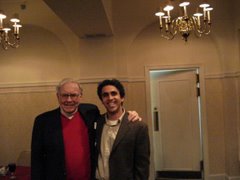Why Prudent Investors Focus on Holding Period Returns
With 2008 finally over, many investors have equity portfolios that have shriveled by 30% to 70%. Simple arithmetic will tell you that if you're down 50% in 2008, you need a 100% return to get back to even. While possible, it will be a remote possibility for many to earn a triple digit return in 2009 considering that many consider it to be a healing year at best.
Whether we like it or not, investing is most beneficial and pays off when done for a period of many years. As such, investors holding securities are better off focusing on holding period returns, which is what really matters. The stock market swings wildly in the short run, but over time, stock prices have always caught up with the underlying fundamentals of the business. Skeptics will correctly argue that investing a dollar invested in the market over the past decade would be worth slightly less today. But I’m not talking about investing in the broad market, but instead individual securities.
One thousand dollars invested in steel producer Nucor would be worth about $20,000 at the end of 2008. The same $1,000 invested in UnitedHealth Group in 1998 would be worth over $15,000 today once you factor in three 2 for 1 stock splits that occurred in 2000, 2003, and 2005. Even boring old Wal-Mart shares would have been worth about $3,000 today in exchange for putting up $1,000 in 1998, and this is not including the dividend. And even and investment in 1998 in Whole Foods which today trades around $9 share, down from an all-time high of $80, would be up over twofold when accounting for the two stock splits.
The market is tough to beat, but you could have easily made satisfactory returns over the past ten years in which the market went nowhere. And these returns would have outperformed real estate, bonds, and just about any other asset class.
The next decade will be no different even if you started in 2008 and can muster the courage and patience to keep going. No one has a clue what the market performance over the next five and ten years will be. But everyone will agree that there will be many companies that will be bigger, better, and more profitable. And Mr. Market doesn’t care about fundamentals in 2008, businesses that continue to improve profit generation will ultimately be recognized.
History Doesn’t Repeat Itself...But It Does Rhyme
Knowing a little market history after the worst year since the Depression can be very instructive. The following chart shows how the Dow has fared during and after recessions.
Recessionary Period (Change in Dow during recession) (Change one year after)
Aug 1929 - March 1933 (-84.2%) (81.1% )
May 1937 - June 1938 (-23.2%) (-2.4%)
Feb 1945 - Oct 1945 (21.3%) (-9.4%)
Nov 1948 - Oct 1949 (-0.12%) (18.7%)
July 1953 - May 1954 (21.6%) (29.7%)
Aug 1957 - April 1958 (-9.9%) (36.8%)
April 1960 - Feb 1961 (7.5%) (6.9%)
Dec 1969 - Nov 1970 (-1.4%) (4.7%)
Nov 1973 - March 1975 (-19.0%) (30.1%)
Jan 1980 - July 1980 (11.5%) (1.9%)
July 1981 - Nov 1982 (7.4%) (22.8%)
July 1990 - March 1991 (1.2%) (11.0%)
Mar 2001 - Nov 2001 (-5.7%) (-9.7%)
The crucial part, of course, is how long our current recession will affect the market. No one truly knows. What we do know is that the market will have turned by the time we get the “official” word.
But another important chart to look at is below.
Company [2001 Price] [2003 Price] [2007 Price]
Apple [$7-$13] [$6 - $12] [$82 - $200]
Vulcan Materials [$37 - $55] [$29 -$49] [$77 - $129]
Tesoro Corp [$5 - $8] [$2 - $7] [$31 - $66]
Transocean [$23 - $57] [$18 -$26] [$73 - $150]
Fluor [$15 -$31] [$10 - $22] [$37 - $86]
Source: Value Line (note: prices reflected low’s and highs for the year are rounded to nearest dollar for illustrative purposes)
The sample above is instructive in showing us how markets behave. Many securities that were bought in 2001 - a year of double digit market declines - were deeply underwater at the end of the year. Two years later many investors were still down by over 50% on many holdings if they had held on. But by 2007, if you had invested in solid companies with great earnings power, you more than made up for it. Even with a 60% two year decline in share value for Fluor shares in the heavy construction firm more than rewarded long-term investors. Assuming you had bought at $25 in 2001, you were down over 50% by 2003. Assuming you had sold at $65 in 2007, your six year holding period return was $160%. I’ll take numbers like that all day.
This recession is vastly worse than the 2001 variety. But as a long-term investor, you should keep your focus on holding period returns and if you stick with businesses that will be doing well a couple of years from now, you’ll realize that stocks can still produce the best returns.
Monday, January 5, 2009
Subscribe to:
Post Comments (Atom)


1 comment:
Great post!
Another value investor here..
Post a Comment